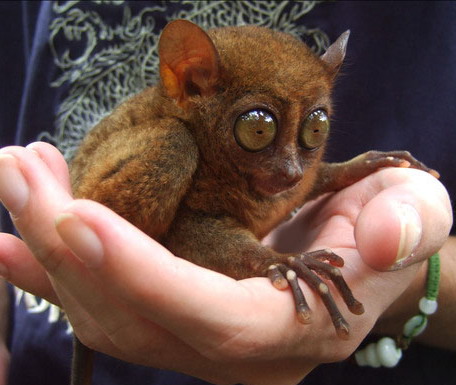
Philippine tarsier(Tarsius syrichta)
Phylum —chordata
Class — mammalia
Order — primates
Family — tarsiidae
Genus –tarsius
Appearance
The Philippine tarsier measures only about 85 to 160 mm (3.35 to 6.30 in) in height, making it one of the smallest primates. The mass for males is between 80–160 g (2.8–5.6 oz), usually lighter for females. The average adult is about the size of an adult human fist.
The Philippine tarsier's eyes are fixed in its skull; they cannot move in their sockets. Instead, a special adaptation in the neck allows its round head to be rotated 180°. Their eyes are disproportionately large, having the largest eye-to-body size ratio of all mammals. These huge eyes provide this nocturnal animal with excellent night vision. In bright light, the tarsier's eyes can constrict until the pupil appears to be only a thin spot. In low light or darkness, the pupil can dilate and fill up almost the entire eye. The large membranous ears are mobile, appearing to be almost constantly moving, allowing the tarsier to hear any movement.
The Philippine tarsier has thin, rough fur which is colored gray to dark brown. The narrow tail, usually used for balance, is bald except for a tuft of hair at the end, and is about twice the body length. Its elongated "tarsus", or ankle bone, which gives the tarsier its name, allows it to jump at least 3 m from tree to tree. Its long digits are tipped with rounded pads that allow to cling easily to trees and to grip almost any surface. The thumb is not truly opposable, but the first toe is. All of the digits have flattened nails, except for the second and third toes, which have sharp claws specialized for grooming.
Habitat
This species is native to the Philippines, where it lives on the islands of Leyte, Samar, Dinagat, Siargao, Bohol, Mindanao, Basilan and Maripipi.
Behavior
Philippine tarsiers are nocturnal but are also active at dawn and dusk. During the day they sleep in dense vegetation or sometimes in a hollow tree. At sunset they begin searching for insect prey. They are agile acrobats, easily leaping vertically from tree to tree. They are largely social, but pair-bonding is done just with the opposite gender. They sometimes associate in groups of four animals or fewer. They demonstrate little fear of other species and especially humans, unless a quick movement is made. When they are threatened they make a high-pitched squeak. Although less vocal than other primates, a tarsier uses a variety of means of communication, including calls for territorial maintenance and the spacing of males and females. They also use scent marks from glandular secretions and to delineate their territories.
Diet
Philippine tarsiers are mainly insectivorous. They consume insects, spiders, lizards, birds and other small vertebrates.
Reproduction
Philippine tarsiers are monogamous, which means that one male mates with one female exclusively. They tend to breed at any time of the year. A single baby is born following a gestation period of about six months. A baby tarsier is very well developed when born, with a full covering of fur and open eyes, and after just one day it is able to climb. As a mother climbs around the trees, her young will cling on to her belly or is carried in her mouth. When 42-60 days old, Philippine tarsiers start to hunt their own insects, and soon after, they are weaned. They usually reach sexual maturity between the age of one and two years.
A healthy Philippine tarsier can live up to 24 years in the wild, but their lifespans tend to decrease significantly in captivity—sometimes by up to 50%.
Incaptivity
Keeping this animal is difficult, so it is only suitable for experienced keepers who have skills in caring for wild exotic animals.
This animal is nocturnal, so during the day it needs to be given time to sleep and rest in a special house.
The diet should consist of live insects: grasshoppers, larvae.
it is important to maintain the appropriate temperature and humidity to avoid colds for a Philippine tarsier.
 Russian
Russian
 English
English























